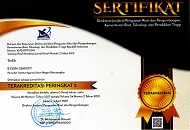BERPIKIR DALAM PENDIDIKAN: (SUATU TINJAUAN FILSAFAT TENTANG PENDIDIKAN UNTUK BERPIKIR KRITIS)
Abstract
his article is a study about how to think in education. Thinking in education should be integrated in process of learning at colleges. In philosophy, thinking in education is one of means of education for critical thinking. Effectively, thinking in education used to study some problems in education. Thinking in education is metacognition. As a part metacognition, critical thinking applied in college will produced a high quality outcomes. In other words, learning process in colleges wich involved lecturers and students interaction if and appropriate process of building the critical thinking pattern. This pattern will effective if the process is formed integratedly the college policies. Since it will affect to all of educational aspect. It is hopped the result of critical thinking in education will be able to help people in drawing a conclusion as well as applying it in their real life.
Kata kunci: thinking, critical thinking, effective, education
Full Text:
PDF (Bahasa Indonesia)References
Abel et al. 2006. Better thinking-better learning; Introduction to Better Thinking. Western Cape Education Departement, South Africa. In http://www.wcape.school.za/curriculum. (Diakses 1 Nopember 2008).
Akshir MAK. 2007. Critical thinking a family resemblance in conceptions. Journal of Education and Human Development Vol 1(2): 11-23.
Al-Jayyousi O. 1999. Introduction of lateral thinking to civil and environmental engineering edu-cation. Int. J. Engng Ed. Vol. 15, No. 3: 199-205.
Al-Quran dan Terjemahannya. Depar-temen Agama RI. PT. Karya Toha Putra. Semarang.
Baillin S, Coombs JR & Daniels LB. 1999. Conceptualizing critical thinking. Journal of Curriculum Studies, 31: 285-302.
Bartlett FC. 1985. Thinking: an experi-mental and social study. London: Allen & Unwin.
Burton HW, Kimbal RB & Wing RL. 1960. Education for effective thinking. New York: Appleton Century Crofts, Inc.
Dewey J. 1944. Democracy and education. New York: The Free Press A Division of Macmillan Publish Co, Inc.
Ennis RH. 1985. A logical basis for measuring critical thinking skills. Educational Leadership (43): 44-48.
Facione PA. 1984. Toward a theory of critical thinking. Liberal Edu-cation, 70: 253-261.
Forman GE. 1968. Constructivism pia-gets, in theory of learning-a com-parative approach. Itaca Illinois: FE Peacock Publishers, Inc.
Haviz, M. 2003. Sukses sebagai maha-siswa plus aktifis. Makalah Se-minar Akademik. Biologi FMIPA Universitas Negeri Padang, 23 April 2003.
Haviz M, Yuzarion, Faulina N, Febrianti D & Agusni. 2007. Kiat-kiat suk-ses menjadi mahasiswa dan aktifis kampus. Makalah Pengabdian kepada Masyarakat. Tanggal 1 Mei 2007. STKIP PGRI Sumbar.
Hirata A. 2005. Laskar pelangi. Edisi pertama. Penerbit Bentang. Yogyakarta.
Hirata A. 2006. Sang pemimpi. Edisi pertama. Penerbit Bentang. Yogya-karta.
Irfaner I. 2006. Enhancing thinking skills in the classroom. Humanity & Social Sciences Journal 1 (1): 28-36.
Jama J. 2008. Pentingnya budaya Ilmiah di UNP. Artikel Surat Kabar Kampus Ganto. Edisi No. 146/Th XIX/Agustus-September 2008.
Kantowitz BH & Roediger HL. 1984. Memory and information processing. in Theory of Learning-a comparative approach. Itasca Illinois: FE Peacock Publishers, Inc.
Levin I & Lieberman E. 2008. Developing Analytical and Synthetic Thinking in Technology Education. in http/www/edu/ thinking tech/(diakses 1 Nopember 2008).
Lipman M. 1988. Critical thinking-what can it be?. Educational Leader-ship, 45: 38-43.
Lufri. 2003. Pembelajaran berbasis problem solving yang diintervensi dengan peta konsep dan pengaruhnya terhadap berpikir kritis mahasiswa dalam mata kuliah perkembangan hewan. Jurnal Penelitian Kependidikan Vol 13. No. 2 Des: 212-228.
McPecks J. 1990. Teaching critical thinking. Great Britain: Routledge.
Paul R. 1995. Critical thinking: how to prepare students for a rapidly changing world. California: Foundational for Critical Thinking.
Pettersen S. 1992. Critical thinking in norwegian upper secondary bio-logy education: The Cases of Complementary-Alternative-Medicine and Health Claims in the Media. Faculty of Vocational Teacher Education, Akershus University College, Lillestrom, Norway.
Ricketts JC. 2004. Critical thinking skills of FFA leaders. Journal of Southern Agricultural Education Research. Vol. 54 (1): 7-20.
Siegel H. 1991. The generalizability of critical thinking. Educational Philosophy and Theory, 23 (1): 18-30.
Sigel IE. 1984. A constructivist perspective for teaching thinking. Educational Leaderships, 42(3): 18-21.
Stein BS, Haynes AF and Unterstein J. 2003. Assesing critical thinking skills. Paper presented at SACS/COC Annual Meeting, Nashville Tennessee Dec 6 – 9 2003.
Wadsworth BJ. 1979. Piaget’s theory of cognitive development, an introduction for students of psychology and education. Second edition. New York: Longman Inc.
Vo HV, Chae B and Olson DL. 2006. Integrating systems thinking into IS education. Syst. Res. 23: 107-121.
DOI: http://dx.doi.org/10.31958/jt.v12i1.158
Refbacks
- There are currently no refbacks.
Copyright (c) 2009 M. HAVIZ

This work is licensed under a Creative Commons Attribution-NonCommercial-NoDerivatives 4.0 International License.
TA'DIB with registered number e-ISSN: 2580-2771, p-ISSN: 1410-8208 have been indexed on:

Journal Ta'dib distribute under Lisensi Creative Commons Atribusi-NonKomersial 4.0 Internasional.
Contact us: Ta'dib; Address: FTIK, Universitas Islam Negeri Mahmud Yunus Batusangkar; Jl. Sudirman No. 137 Lima Kaum Batusangkar, Tanah Datar, Sumatera Barat, Indonesia. Email: takdib@uinmybatusangkar.ac.id

























